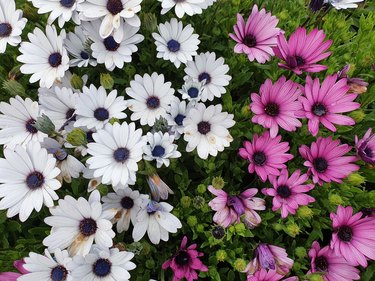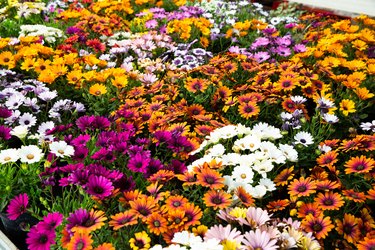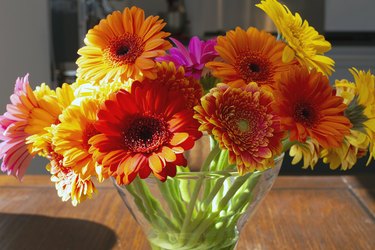
"Deadheading" sounds like a drastic term for pinching flowers from a plant, yet when you deadhead an African Daisy (Osteospermum), you are actually encouraging a new birth of blossoms. Once the flower turns brown, droops and is unsightly, snipping it off toward the end of its growing season allows for a last minute burst of color from new growth. African Daisies can get "leggy" as they grow, and deadheading and even pruning the long skinny stems encourages the plant to fill out and become fuller and bushier. Deadheading, in spite of the sound of the word, is a good thing.
Tip
You can prevent your African Daisy from becoming leggy by pinching off the growing tips of young plants. Twice in the early summer before budding should control the growth.
Video of the Day
Recognizing the Different Osteospermum Species
The common name for daisy-like flowers within the osteospermum species is African Daisy. As its name suggests, a warm climate in U.S. Department of Agriculture hardiness zones 9-10 or above is ideal for growing the African Daisy as a perennial. In cooler climes, it becomes an annual. The variety extends to the shape and color of the petal and the color of the eye.
Video of the Day
The Blue-Eyed Beauty (Osteospermum ecklonis) is multi-colored, with a center that is blue and yellow and petals that start out purple near the center and transition to yellow toward the tip. The Astra Purple Spoon (Osteospermum 'Astra Purple Spoon'), with pink and blue fluted petals, looks like a small, ornate spoon. Lemon Symphony (Osteospermum 'Lemon Symphony') features an orange dot in the middle of the flower, and the Soprano White (Osteospermum 'Soprano white') boasts white petals and a blue center surrounded by yellow and purple rings.
Summer Blooming Flowers

If you want a kaleidoscope of color bursting from your garden, the African Daisy is a flower that blooms all summer long. Tough and tolerant, it thrives even in drought conditions and when the soil is less than optimal. Other than deadheading to keep your garden neat and to promote new growth, African Daisies need little care or attention with the exception of water. Their heritage, having originated in the sandy, rocky terrain of South Africa, allows for hot summer temperatures; however, when temperatures climb extremely high you'll notice that flowering decreases while the plant itself turns to survival mode in the heat.
The African Daisy also closes up at night or won't open in dreary weather. May and June are the best planting months, with flowering throughout the summer and into fall, depending on the weather. Prune and deadhead as needed, especially in March and April for flowers that have survived the winter, and August and September for spent flowers.
Deadhead an African Daisy
Arm yourself with sharp scissors or a secateur that is clean and preferably sterilized to avoid spreading plant diseases from flower to flower. As soon as wilt sets in, cut down to the juncture of the next set of leaves. You can easily pinch off the dead flower heads with your fingers or use tools. The plant doesn't need pruning, but it does need deadheading if you want continuous flowering. Sunlight is vital to the daisy's health, and if some of the plant doesn't get ample sun, deadhead those flowers to prevent fungal disease and aphids.

Pinching healthy buds before they flower also helps the plant become less scraggly and more bushy. You can even cut the plant all the way to the ground in early spring and start over with new flowers, leaves and a healthy blooming African Daisy.